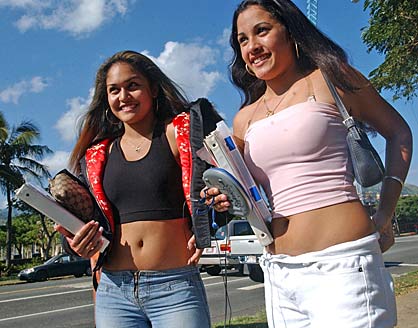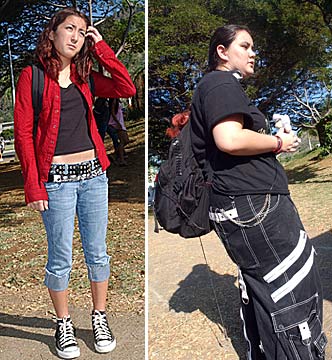
|
Dressed for
detention
Students, educators and even
parents continue to clash over
mandating school uniforms
and what is "decent" attire
A pink tube top hugged her chest and her white corduroy pants were turned down at the hips, baring 14-year-old Kailani Gracie's tanned shoulders and several inches of midriff.
Dress code facts
Where: Kamalii Elementary in Kihei, Maui, was the first Hawaii public school to adopt uniforms in 1996. Now, nearly 40 of the state's 256 public schools have followed suit, largely at the middle and elementary level. Private schools in the islands have also started dress codes or introduced uniforms.
Why: To address concerns about inappropriate attire. To make it easier to distinguish who belongs on campus and who doesn't. To boost school pride. To prepare students for the working world.
|
"We go to school for our education, not for them to tell us what to wear," she said recently at the bus stop after school. "This is how I like to dress. My mom is the one who buys me these clothes. She knows I'm old enough to make my own decisions."
The spread of flesh-baring fashion is creating headaches for administrators in public and private schools alike. While kids have bucked dress codes for generations, the amount of skin exposed has reached new dimensions, pushing the issue of student clothing -- or lack of it -- to the forefront on some campuses.
Kaiser High School in Hawaii Kai cracked down on dress-code violations this semester, triggering a steady stream of students to the office -- as many as 29 in one day, according to Principal Larry Kaliloa. At Punahou School, Academy Principal Kevin Conway said the subject of student dress consumes more of his time than any other.
"I could not even come up with a close second," Conway told parents at a Dec. 9 meeting on "attire policy," which laid out options, including uniforms, being considered at Punahou. "The topic of student attire, for some reason I don't understand, can be a lightning rod for emotion."
Facing a gulf between what staff and students consider appropriate, more schools are resorting to uniforms. Since Kamalii Elementary in Kihei, Maui, became the first Hawaii public school to adopt uniforms in 1996, nearly 40 of the state's 256 public schools have followed suit, largely at the middle and elementary level.
Most mandate only that students wear school shirts, and parents may request exemptions for their kids.
"The girls -- it's ridiculous what they wear," said Natalie Kaeo, a clerk at Nanakuli High and Intermediate School, which adopted uniform shirts two years ago and still faces some resistance. "It doesn't leave much to the imagination. We're in class. We're not going downtown, we're not going to the beach. You've got to cover all that stuff up."
Kamehameha Schools began requiring uniforms for its high school students three years ago, and has found it much easier to enforce than a dress code, said Renee Martin, a vice principal. Last school year, Mid-Pacific Institute began mandating that its high school students wear collared shirts or school T-shirts, and pants or shorts with a "natural waistline."
"It's not quite a uniform, but it's a more uniform look," said Julie Halpern, director of student services at the private school in Manoa. "It's kind of a happy medium. The first year there were a lot of girls in my office, saying, 'I want my freedom!' But now, it's a non-issue."

Kaiser High School students Justi Dunhour, right, sat beside Shylynn Duarte, together with other students waiting at the bus stop on Dec. 16 along Lunalilo Home Road. The school cracked down on dress-code violations last semester.
"We do not have those problems any more," she said. "It's been really, really great."
Uniforms are generally a tougher sell at the high school level. Teenagers, in the throes of defining their identities, consider it their right to express themselves through clothing -- and some of their parents back them up. Along with Nanakuli, three public high schools have tried mandating school shirts. Compliance is best at Campbell in Ewa Beach. Waianae has had mixed results. Waiakea High in Hilo abandoned uniforms after a few years of struggle.
Lately, uniforms have been promoted as a safety measure, because they make it easier to distinguish who belongs on campus and who doesn't. They also are seen as a way to boost school pride and blur socioeconomic distinctions. Proper dress -- uniform or not -- is billed as a way to prepare students for the working world.
Many educators see the dress-code dilemma as part of a broader social issue. Students, they say, aren't trying to push the limits at school, they are simply reflecting what they see around them -- on television, in the movies and in the entertainment world.
"I don't think students are deliberately trying to shock people with what they wear," said Kaliloa, Kaiser's principal. "Students are actually just doing what they see society is doing. I think it's just a matter of what they see being sold in the stories and in our media and all the advertisements."
Still, many teachers feel the overt sexuality of today's clothing detracts from the learning environment. Kaiser's policy prohibits bikini tops, strapless tops and camisoles, as well as T-shirts that promote gangs, drugs, alcohol, racism or sexism. Midriffs must be covered, along with buttocks and breasts.
"My feeling is that we cannot move on to uniforms until we actually have taken the dress code and tried to enforce it consistently," Kaliloa said. "And that's where we're at right now."
Punahou has tried that tack, with little success. The school made a concerted effort to enforce its dress code two years ago, holding assemblies, counseling students, calling parents, even sending students home, according to Marguerite Ashford, freshman academy dean.
"We neglected our other work to focus on this one issue," she said. "Girls took F's in citizenship because of repeated dress-code violations. Our efforts were exhausting. They damaged relations with students and families. ... We couldn't make the dress code stick."

Kaiser High students Crystal Lee, left, and Adrie Rappa show what's comfortable for them. Bikini and strapless tops are among banned clothing.
Defining what is "appropriate" wear is subjective for adults as well as kids. Students can comply with dress codes by covering up, then defy the rules moments later. Some male teachers are reluctant to reprimand girls for flaunting their bodies for fear of being accused of sexual harassment.
Many parents believe that the way teenagers dress should be left up to the family. Making students dress alike, some say, teaches them to follow the crowd rather than think for themselves.
Parents who resisted dress codes in the 1960s and '70s -- governing the length of boys' hair and girls' skirts -- consider the current debate a fuss over nothing. Why enforce a dress code on campus, they wonder, if there is none on the street?
Kaiser junior Nolan Leonguerrero dismissed the argument that girls who flaunt their bodies -- popularly known as "hootchie mamas" -- are a distraction at school.
"You see it every day -- you're used to it already," he said with a shrug, lounging on the grass in a T-shirt emblazoned with the words "Eat my giant burrito."
But some students say they are "grossed out" by the way some of their classmates dress.
And some adults fear the sexual nature of American popular culture is warping young girls' sense of their own worth. Schools, they believe, should serve as a buffer to that.
"Our current cultural environment is especially toxic toward our girls," Punahou Assistant Principal Paula Hodges told parents at the December meeting. "Given what we know about the deep commercial investment in our girls' bodies, individual autonomy has been oversold."
She spoke after a slide show chronicled the evolution of student clothing on the exclusive Manoa campus. Outside of a brief flirtation with miniskirts in the 1960s, the outfits were relatively staid until the last few years, when girls' tops shrank dramatically and pants for both sexes slid to new lows.
Dee Ching, a computer resource specialist at Punahou who has daughters in sixth and 10th grades, hopes Punahou adopts uniforms, and predicted that "it'll happen -- it's a question of when."
But parent Laurel Schuster, who has attended and taught at schools both with uniforms and without, doesn't want them at Punahou. She prefers to work with her daughters, aged 12 and 15, to guide them in making appropriate choices in clothing, rather than have the school dictate to them.
"I'd rather they don't go to uniforms, because I don't think they're going to solve anything and I think there's going to be a lot of resentment," she said. "The key is that parents talk to their kids."
Punahou sophomore Chloe Hartwell called uniforms "an awful idea."
"Students need to understand we are going to get a uniform if we don't start being conscientious and making sure that we are in the dress code," she warned. "We are going to suffer for it."
[News] [Business] [Features] [Sports] [Editorial] [Do It Electric!]
[Classified Ads] [Search] [Subscribe] [Info] [Letter to Editor]
[Feedback]
